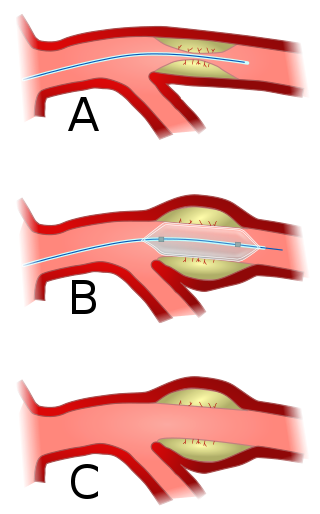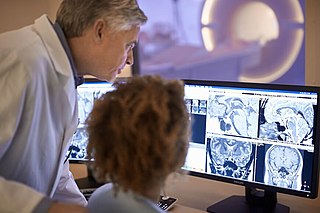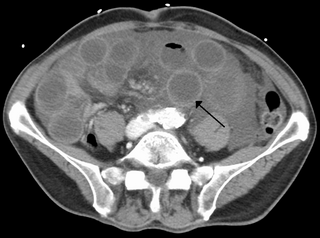Related Research Articles

Angioplasty, also known as balloon angioplasty and percutaneous transluminal angioplasty (PTA), is a minimally invasive endovascular procedure used to widen narrowed or obstructed arteries or veins, typically to treat arterial atherosclerosis.

Radiology is the medical specialty that uses medical imaging to diagnose diseases and guide their treatment, within the bodies of humans and other animals. It began with radiography, but today it includes all imaging modalities, including those that use no ionizing electromagnetic radiation, as well as others that do, such as computed tomography (CT), fluoroscopy, and nuclear medicine including positron emission tomography (PET). Interventional radiology is the performance of usually minimally invasive medical procedures with the guidance of imaging technologies such as those mentioned above.

The femoral artery is a large artery in the thigh and the main arterial supply to the thigh and leg. The femoral artery gives off the deep femoral artery and descends along the anteromedial part of the thigh in the femoral triangle. It enters and passes through the adductor canal, and becomes the popliteal artery as it passes through the adductor hiatus in the adductor magnus near the junction of the middle and distal thirds of the thigh.

In medicine, a stent is a tube usually constructed of a metallic alloy or a polymer. It is inserted into the lumen of an anatomic vessel or duct to keep the passageway open. Stenting refers to the placement of a stent. The word "stent" is also used as a verb to describe the placement of such a device, particularly when a disease such as atherosclerosis has pathologically narrowed a structure such as an artery.

Interventional radiology (IR) is a medical specialty that performs various minimally-invasive procedures using medical imaging guidance, such as x-ray fluoroscopy, computed tomography, magnetic resonance imaging, or ultrasound. IR performs both diagnostic and therapeutic procedures through very small incisions or body orifices. Diagnostic IR procedures are those intended to help make a diagnosis or guide further medical treatment, and include image-guided biopsy of a tumor or injection of an imaging contrast agent into a hollow structure, such as a blood vessel or a duct. By contrast, therapeutic IR procedures provide direct treatment—they include catheter-based medicine delivery, medical device placement, and angioplasty of narrowed structures.

Vascular surgery is a surgical subspecialty in which vascular diseases involving the arteries, veins, or lymphatic vessels, are managed by medical therapy, minimally-invasive catheter procedures and surgical reconstruction. The specialty evolved from general and cardiovascular surgery where it refined the management of just the vessels, no longer treating the heart or other organs. Modern vascular surgery includes open surgery techniques, endovascular techniques and medical management of vascular diseases - unlike the parent specialities. The vascular surgeon is trained in the diagnosis and management of diseases affecting all parts of the vascular system excluding the coronaries and intracranial vasculature. Vascular surgeons also are called to assist other physicians to carry out surgery near vessels, or to salvage vascular injuries that include hemorrhage control, dissection, occlusion or simply for safe exposure of vascular structures.

In medicine, aortoiliac occlusive disease is a form of central artery disease involving the blockage of the abdominal aorta as it transitions into the common iliac arteries.

Ischemic colitis is a medical condition in which inflammation and injury of the large intestine result from inadequate blood supply. Although uncommon in the general population, ischemic colitis occurs with greater frequency in the elderly, and is the most common form of bowel ischemia. Causes of the reduced blood flow can include changes in the systemic circulation or local factors such as constriction of blood vessels or a blood clot. In most cases, no specific cause can be identified.

Endovascular aneurysm repair (EVAR) is a type of minimally-invasive endovascular surgery used to treat pathology of the aorta, most commonly an abdominal aortic aneurysm (AAA). When used to treat thoracic aortic disease, the procedure is then specifically termed TEVAR for "thoracic endovascular aortic/aneurysm repair." EVAR involves the placement of an expandable stent graft within the aorta to treat aortic disease without operating directly on the aorta. In 2003, EVAR surpassed open aortic surgery as the most common technique for repair of AAA, and in 2010, EVAR accounted for 78% of all intact AAA repair in the United States.

Intestinal ischemia is a medical condition in which injury to the large or small intestine occurs due to not enough blood supply. It can come on suddenly, known as acute intestinal ischemia, or gradually, known as chronic intestinal ischemia. The acute form of the disease often presents with sudden severe abdominal pain and is associated with a high risk of death. The chronic form typically presents more gradually with abdominal pain after eating, unintentional weight loss, vomiting, and fear of eating.

Peter Lin is an American vascular surgeon, medical researcher, specializing in minimally invasive endovascular treatment of vascular disease. He has published extensively in the area of vascular surgery and endovascular surgery.
Julio Palmaz is a doctor of vascular radiology at University of Texas Health Science Center at San Antonio. He studied at the National University of La Plata in Argentina, earning his medical degree in 1971. He then practiced vascular radiology at the San Martin University Hospital in La Plata before moving to the University of Texas Health and Science Center at San Antonio. He is known for inventing the balloon-expandable stent, for which he received a patent filed in 1985. It was recognized in Intellectual Property International Magazine as one of "Ten Patents that Changed the World" in the last century. His early stent research artifacts are now part of the medical collection of the Smithsonian Institution in Washington, DC. He continues to innovate on his initial designs, developing new endovascular devices.
Transradial catheterization is an endovascular procedure or catheterization procedure performed to diagnose and treat arterial disease. Endovascular procedure can be performed achieving access in to body’s arterial system from either femoral artery, brachial artery or radial artery in the wrist. The transfemoral approach to perform cardiac catheterization has typically been more prevalent in invasive cardiology. But radial access has gained popularity due to technical advances with catheters and lower complication rates than transfemoral access. The European Society of Cardiology and the American Heart Association both support a radial-first approach in acute coronary syndrome.
The Society of Interventional Radiology (SIR) is an American national organization of physicians, scientists and allied health professionals dedicated to improving public health through the use of minimally invasive, image-guided therapeutic interventions for disease management.
Interventional neuroradiology (INR) also known as neurointerventional surgery (NIS), endovascular therapy (EVT), endovascular neurosurgery, and interventional neurology is a medical subspecialty of neurosurgery, neuroradiology, intervention radiology and neurology specializing in minimally invasive image-based technologies and procedures used in diagnosis and treatment of diseases of the head, neck, and spine.
Camilo Ramiro Gomez, is an American neurologist, medical educator, and researcher. He is one of the first 100 vascular neurologists certified by the American Board of Psychiatry and Neurology (ABPN), and one of the founders of the subspecialty of interventional neurology in the United States.
Anne Christine Roberts is an American interventional radiologist who is credited with the invention of the Roberts Uterine Catheter (RUC), a catheter designed to facilitate navigation through the uterine arteries and currently used widely for uterine artery embolization procedures. She also served as president of the Society of Interventional Radiology (SIR) (1996-1997) and was the second woman to become president of the society.
Elad I. Levy is an American neurosurgeon, researcher, and innovator who played a major role in the development and testing of thrombectomy, which improved quality of life and survival of stroke patients. He has focused his career and research on developing evidence based medicine and literature showing the benefits of thrombectomy for the treatment of stroke. He is currently Professor of Neurosurgery and Radiology, and the L. Nelson Hopkins, MD Professor Endowed Chair of the Department of Neurosurgery at the State University of New York at Buffalo (SUNY).

Nicolai Leontievich Volodos, was a Soviet/Ukrainian cardiovascular surgeon and scientist. An innovator, Volodos developed and introduced into clinical practice the world's first endovascular stent graft for the treatment of stenotic and aneurysmal diseases of arterial system. Volodos was described by his colleagues as ”a pioneer innovator and a giant in vascular and endovascular surgery” and ”a giant of historic proportions in the vascular and endovascular specialties, and the father of endovascular grafting”.
Anna-Maria Belli, MD, FCIRSE is a British interventional radiologist known for her work in vascular interventional radiology and for holding leadership positions in interventional radiology societies in Britain and Europe.
References
- ↑ "Mentoring needed to draw more women into IR - Interventional News". Interventional News. 2015-09-10. Retrieved 2018-09-15.
- ↑ Krol, Katharine L.; Saxon, Richard R.; Farhat, Naim; Botti, Charles F.; Brown, O. William; Zemel, Gerald; Raabe, Rodney D.; Voorhees, William D.; Katzen, Barry T. (January 2008). "Clinical Evaluation of the Zilver Vascular Stent for Symptomatic Iliac Artery Disease". Journal of Vascular and Interventional Radiology. 19 (1): 15–22. doi:10.1016/j.jvir.2007.08.031. ISSN 1051-0443. PMID 18192463.
- ↑ Maglinte, D. D.; Caudill, L. D.; Krol, K. L.; Chernish, S. M.; Brown, D. L. (1982). "The minimum effective dose of glucagon in upper gastrointestinal radiography". Gastrointestinal Radiology. 7 (2): 119–122. doi:10.1007/BF01887622. ISSN 0364-2356. PMID 7084592. S2CID 27811641.
- ↑ Krol (April 2006). "An interview with Katharine L. Krol, MD". Endovascular Today. Retrieved 2024-03-18.
- ↑ "Endovascular Today - New Coding for Endovascular Stroke Therapy in 2016". Endovascular Today. Retrieved 2018-09-15.
- ↑ https://evtoday.com/pdfs/et0313_F2_Krol.pdf [ bare URL PDF ]
- ↑ https://evtoday.com/pdfs/et0816_Coding_Krol.pdf [ bare URL PDF ]
- ↑ "Society of Interventional Radiology Recognizes 2017 Gold Medal Winners". Imaging Technology News. 2017-03-14. Retrieved 2018-09-15.
- ↑ "Society of Interventional Radiology - SIR 2020 Executive Council". www.sirweb.org. Retrieved 2024-03-18.
- ↑ "Society of Interventional Radiology Names New President". Imaging Technology News. 2022-06-17. Retrieved 2024-03-18.